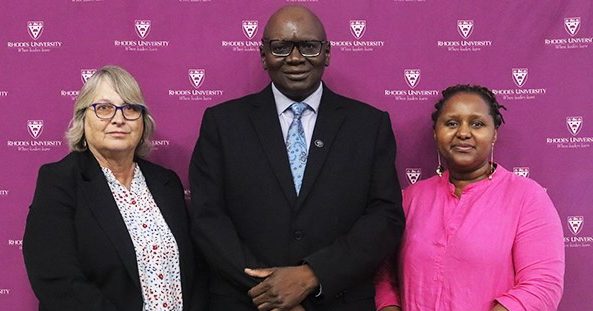By Siyamthanda Hobo
On 15 May 2024, Rhodes University hosted the 2019 Vice Chancellor’s Distinguished Research Award lecture with recipient Professor Makaiko Chithambo, Head of the Department of Physics and Electronics.
The Vice-Chancellor’s Distinguished Senior Research Award is made annually to a staff member of Rhodes University, to recognise their indisputable academic status, engagement in research and general scholarly activity.
Prof Chithambo’s lecture delved into the intriguing realm of materials science, specifically focusing on the significant role of imperfections in solid materials. Setting the stage, DVC of Research, Innovation and Strategic Partnerships, Dr Kwezi Mzilikazi introduced Prof Chithambo, emphasising the importance of the topic at hand and the insights that were about to be shared.
Professor Chithambo commenced the lecture by presenting a fundamental concept: the idea that the characteristics of solid materials are defined by their imperfections rather than by their perceived perfection.
To illustrate this concept, Professor Chithambo began by depicting a hypothetical perfect solid, characterised by a two-dimensional lattice of atoms arranged in a periodic and repetitive manner. However, such ideal structures do not exist. Instead, imperfections such as vacancies (missing atoms) and substitutional atoms (atoms replacing others) are prevalent and play a crucial role in determining the physical properties of materials.
Going deeper into the necessity of imperfections, Prof Chithambo turned to the realm of thermodynamics to explain how the state of a material can be quantified through thermodynamic properties such as entropy, which is a measure of disorder. In the context of solids, the presence of vacancies contributes to a material attaining an equilibrium state, highlighting the natural and inevitable nature of imperfections in solid materials.
Introducing the concept of Gibbs free energy, Professor Chithambo elaborated on the equilibrium of solids, emphasising that at equilibrium, the number of defects in a solid is not zero. This underscores the essential role of imperfections in maintaining equilibrium and further explains their significance in shaping material properties.
Throughout the lecture, Professor Chithambo provided numerous practical examples to illustrate the importance of imperfections in solid materials. One such example was the alloying of copper, tin and zinc to produce bronze. While pure copper is soft and malleable, the introduction of imperfections through alloying elements significantly enhances its strength and durability, making bronze a highly valued material in various applications.
Another example highlighted the role of imperfections in gemstones. The colour and value of gemstones such as rubies and tanzanite are often attributed to impurities within their structures. For instance, rubies derive their vibrant red colour from chromium impurities embedded within the aluminium oxide lattice.
Furthermore, Professor Chithambo discussed the formation of amorphous materials, such as glass, which lack the long-range order characteristic of crystalline solids. Instead, glass is formed by rapidly cooling a liquid, resulting in a solid with a disordered structure. Despite their apparent imperfections, amorphous materials possess unique properties that make them invaluable in various industries.
The lecture also touched upon the crucial role of imperfections in electronic devices. In semiconductor materials, imperfections facilitate the movement of electrons, which is essential for the operation of devices such as cell phones and credit card chips. By understanding and manipulating these imperfections, scientists can enhance the performance and efficiency of electronic devices, driving innovation in the field of electronics.
Shifting focus to luminescence, Professor Chithambo discussed various methods used to study defects in solids, including thermoluminescence, which measures the light emitted by an irradiated material as it is heated at a controlled rate. This method provides valuable insights into the concentration of defects within a material and aids in understanding its solid-state dynamics.
The lecture accentuated the beauty and necessity of imperfections in solid materials. By embracing these imperfections, scientists can better understand material properties and harness them for various practical applications.
The event at Rhodes University served as a platform for advancing knowledge in the field of materials science and highlighted the intricate relationship between imperfections and material properties. As attendees departed with newfound insights, the significance of ongoing research in this area was reaffirmed, promising further discoveries and advancements in the future.
This article was first published by the Rhodes University Communications Division.


